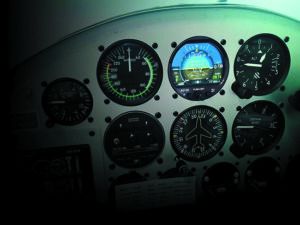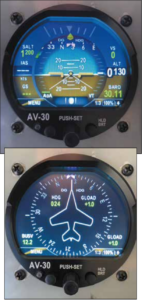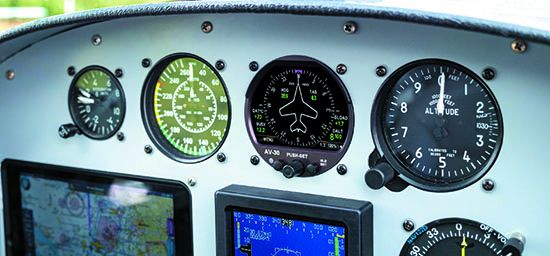Shop the budget EFIS market and you’ll consider the uAvionix AV-30. At just shy of $2000 for the certified version ($1495 for experimentals), the drop-in flight instrument packs a healthy punch in a round-gauge chassis. But there are limitations to consider, particularly when it comes to GPS and autopilot interfaces.
Plenty of potential buyers we talk with are confused about the AV-30 product line, so here in simple language is a dose of ninja planning to help qualify an interface.

TWO VERSIONS
Start by choosing the right one. Part 23 certified aircraft are limited to the STC-approved AV-30-C, and amateur-built experimentals and LSAs can use the AV-30-E. From a hardware and features standpoint, they’re identical, and both share most of the same 14-function capabilities. The short list includes built-in angle of attack, audio alerting, altitude alerting and primary slip indication. But the AV-30-C has certified operating software and an STC with approved model list (AML) that blankets a wide variety of single-engine aircraft with speeds below 200 knots. It’s approved as a standalone attitude indicator, as an electronic DG, as a replacement for a slip-skid indicator (it doesn’t have rate of turn—just a skid ball) and it can be used as the required backup attitude display for the majority of primary EFIS systems. A dual-unit installation is fair game for removing the aircraft’s vacuum system, but that could need extra approvals or paperwork on the shop level—the specifics of removing the vacuum system are outside the scope of the instrument’s STC.
The AV-30-C isn’t TSO approved, but the attitude display is still worthy of primary VFR/IFR navigation when locked in the attitude mode—something the installer is instructed to do during configuration. When used as a DG, you can still have access to attitude data as a backup. But that’s where the real-world IFR functionality of the AV-30 series ends. More on that in a minute.
Some buyers use the AV-30 as a secondary unit (with traditional flight instruments or for backing up an EFIS), but the more common interface may be in aircraft already limited to VFR. A pair of AV-30s—one as an attitude display, plus electronic pitot static instruments (in certified aircraft you still have to retain the originals)—and the other as a heading indicator is a good way to give an old VFR panel a new lease on life, in our view. It shouldn’t break the budget. A relatively simple installation should keep invoices in check.
In terms of the physical installation a major draw is the AV-30’s ability to drop in to an existing 3 1/8-inch instrument cutout without having to cut metal—or plastic overlays, if they exist. This no-cut install has been a major selling point for Garmin’s pricier GI 275 flight instrument series, which has a TSO, an STC and more capable IFR navigation capability. Here’s why.
ANATOMY OF AN INSTALL

Let’s look at one potential upgrade—with budget IFR capability as the goal—to see what an AV-30-C can and can’t do.
The old Piper Cherokee has a King KX155 navcomm, a transponder and stock traditional flight instruments. The plan, to save some money, is to install a used Garmin GNS 430W and retain the KX155 radio as the secondary system. To move the airplane into the age of glass, consider dual AV-30-C instruments—one in the attitude indicator position and the other to replace the precessing DG that’s been rebuilt more times than it deserves.
There is no need for the vacuum system since the AV-30 (with battery backup) is electronic. To the rubbish bin with the vacuum system, with an FAA Form 337 as proof. You’ll still need to retain the airspeed, altimeter and vertical speed indicators, even though your eyeballs will be focused on the supplementary ones inside the instrument. The AV-30 plumbs into the existing pitot and static system for reference, although it has self-contained solid state gyros for attitude and heading.
On a side note, expect to spend some time and money to repair even minor leakage in the static system. Electronic instruments are less tolerant of leak-induced error. In some cases, the leakage might be in one of the supporting pitot static instruments. This means you might have to spend money on replacements or overhaul to cure a leak. Keep up with pitot static inspections—even though you aren’t required to for VFR flying. The snag comes when it’s time to connect the GNS 430W WAAS navigator to the electronic DG’s HSI because it only accepts RS-232 serial data for input. The result is that the HSI mode of the AV-30 only displays lateral guidance. And even if you hook up a navcomm with nav output using the RS-232 (a Garmin SL-30 is one example), the instrument only displays lateral guidance. To solve this bugaboo, uAvionics is presumably working on an external ARINC 429 digital adapter, as Garmin did with its G5 instrument.
And since the King KX155 only has an analog nav output for its VOR, localizer and glideslope radio, it won’t play at all on the AV-30. This means both the GNS 430W and the KX155 will need to be interfaced with their own indicators.
But for VFR GPS with RS-232 output (which is just about anything made in the last 20 years at least), the AV-30 will display lateral course guidance and digital waypoint data.
WHAT ABOUT AUTOPILOTS?
At press time, uAvionix announced a new autopilot interface for the AV-30-E experimental version. It interfaces with the TruTrak 385 and Vizion PMA systems, plus the BendixKing xCruze 100 and AeroCruze 100 for heading command.
As for the S-TEC roll-axis autopilot that’s in our example Piper, the AV-30 won’t work. That means if you have an S-TEC (or Century/Piper Autocontrol—two common systems) you’ll need to retain the directional gyro if you want to maintain heading bug functionality. You can still have nav tracking capability, since the GNS 430W and King KX155 Left/Right steering outputs are wired directly into the autopilot, and are separate from the AV-30.
The AV-30 series doesn’t have synthetic vision or even a terrain display, but the AV-30-E experimental version has a traffic interface using the uAvionix plug-in wireless AV-Link adapter. Think of the 15-pin device as an inline Wi-Fi bridge for the display that we suspect will also be used for future functionality, but for now it’s a way to stream ADS-B traffic data to the AV-30 for displaying standard ADS-B traffic symbology. Any portable ADS-B In receiver that works via the industry standard GDL90 Wi-Fi protocol can interface with the display just as it’s done with an iPad.
Since our example Piper needs ADS-B Out, it’s logical to consider the uAvionics skyBeacon or tailBeacon systems, which also have LED lighting. But taking the interface a step higher is the company’s tailBeaconX 1090ES diversity-based ADS-B transponder, currently in development, and back on the table for a requirement in Canadian ADS-B airspace. uAvionix announced a trade-up program for up to $1200 toward a tailBeaconX, and since that device will need a control head, the AV-30-series is positioned to do just that—tune the transponder on the AV-30’s screen. We’ll look at that interface as it evolves.
And when it comes to interfacing, if uAvionix can hammer out the vertical nav function of the AV-30 series (in addition to more autopilot interfaces), it would seal the deal for a lot more buyers needing IFR nav capability. Visit www.uavionix.com.





